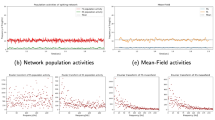Summary
-
1.
The lateral line lobe of the bullhead catfishIctalurus nebulosus was found to contain two types of higher-order neurons which can be activated antidromically from the mesencephalon and which respond to weak (2.5×10−5 μa/mm2) current stimulation of the lateral line electroreceptors.
-
2.
The response of these neurons to weak current stimulation is reciprocal, one type responding with an increase in spike frequency to cathodal receptor stimulation, the other with an increase in response to an anodal current. One type was found to receive a monosynaptic excitation from the ipsilateral lateral line nerve, whereas the second type was found to receive a disynaptic inhibition. This difference in synaptic inputs probably accounts for the difference in the response of the two types to receptor stimulation of a particular polarity.
-
3.
The receptive fields of both types were found to be distributed over the entire body and head with greatest density on the head and on the caudal peduncle.
-
4.
The steady state frequency response of these neurons indicates that both types have characteristic (best response) frequencies which are lower than those of the electroreceptive primary afferents.
-
5.
The spike activity of lemniscal neurons was strongly modulated by the respiratory potentials generated by a small fish 7 cm away. A Fourier analysis of the potentials recorded from small fish and from one species of aquatic arthropod indicates that there is a good match between their frequency spectra and the steady-state bandpass characteristics of the lemniscal units.
Similar content being viewed by others
References
Alnaes, E.: Lateral line inputs to the crista cerebellaris in the eel: Field potentials and histology. Acta physiol. scand.88, 35–48 (1973)
Andrianov, G., Ilyinsky, O.: Some functional properties of central neurons connected with the lateral line organs of the catfish (Ictalurus nebulosus). J. comp. Physiol.86, 365–376 (1973)
Barham, E., Huckaby, W., Croudy, R., Brown, B.: Microvolt signals from fish and the environment. Science164, 965–968 (1969)
Bastian, J.: Electrosensory inputs to the corpus cerebelli of the high frequency electric fishEigenmannia virescens. J. comp. Physiol.90, 1–24 (1974)
Bastian, J.: Receptive fields of cerebellar cells receiving exteroceptive input in a Gymnotid fish. J. Neurophysiol.38, 285–300 (1975)
Berkelbach Van der Sprenkel, H.: The central relations of the cranial nerves inSilurus glanis andMormyrus cashive. J. comp. Neurol.24, 1–63 (1915)
Dunning, B.B.: A quantitative and comparative analysis of the tonic electroreceptors ofGnathonemus, Gymnotus andKryptopterus. Ph.D. Thesis, University of Minnesota Graduate School, Minneapolis, Minnesota (1974)
Enger, P., Szabo, T.: Activity of central neurons involved in electroreception in some weakly electric fish (Gymnotidae). J. Neurophysiol.28, 800–818 (1965)
Forbes, A.: The fishes of Illinois. Springfield, Illinois: Illinois State Journal Company, State Printers 1920
Goldberg, T., Brown, P.: Responses of binaural neurons of dog superior olivary complex to dichotic tonal stimuli. J. Neurophysiol.32, 613–636 (1969)
Heiligenberg, W.: Electrolocation and jamming avoidance in aHypopygus (Rhamphichthyidae, Gymnotoidei) an electric fish with pulse-type discharges. J. comp. Physiol.91, 223–240 (1974)
Herrick, C.: The cranial nerves and cutaneous senses of the North American Siluroid fishes. J. comp. Neurol.11, 177–247 (1901)
Kalmijn, A.: The electric senses of sharks and rays. J. exp. Biol.55, 371–383 (1971)
Kalmijn, A.J.: The detection of electric fields from inanimate and animate sources other than electric organs. In: Electroreceptors and other specialized receptors in lower vertebrates. Handbook of sensory physiol. Vol. III/3 (A. Fessard, ed.), pp. 147–200, Berlin-Heidelberg-New York: Springer 1974
Larsell, O.: The comparative anatomy of the cerebellum, Vol. I. Minneapolis, Minnesota: University of Minnesota Press 1967
McCreery, D.B.: Spatial organization of receptive fields of lateral lemniscus neurons of the lateral line lobe of the catfishIctalurus nebulosus. J. comp. Physiol.213, 341–353 (1977)
Moore, G., Perkel, D., Levitan, H.: Statistical signs of synaptic interactions in neurons. Biophys. J.10, 876–899 (1970)
Papoulis, A.: Probability, random variables and stochastic processes. New York: McGraw-Hill Book Company 1965
Pearson, A.: The acousticolateral nervous system in fish. J. comp. Neurol.64, 235–271 (1936)
Peters, R., Bretschneider, F.: Electric phenomena in the habitats of the catfishIctalurus nebulosus. J. comp. Physiol.81, 345–362 (1972)
Peters, R., Buwalda, R.: Frequency responses of the electroreceptors (“small pit organs”) of the catfish,Ictalurus nebulosus. J. comp. Physiol.79, 29–38 (1972)
Peters, R., Meek, J.: Catfish and electric fields. Experientia153, 399–400 (1973)
Roth, A.: Electroreception in the catfishAmiurus nebulosus. Z. vergl. Physiol.61, 196–208 (1968)
Roth, A.: Elektrische Sinnesorgane beim ZwergwelsIctalurus nebulosus. Z. vergl. Physiol.65, 368–387 (1969)
Roth, A.: Wozu dienen die Elektroreceptoren der Welse? J. comp. Physiol.79, 113–135 (1972)
Roth, A.: Central neurons involved in electroreception of the catfishKryptopterus. J. comp. Physiol.100, 135–146 (1975)
Schlegel, P.: Perception of objects in the weakly electric fishGymnotus carpo as studied in recordings from rhombencephalic neurons. Exp. Brain Res.18, 340–354 (1973)
Schlegel, P.: Activation of rhombencephalic units in Mormyrid fish. Exp. Brain Res.19, 300–313 (1974)
Segundo, J.: Communication and coding by nerve cells. In: Neurosciences second study program. New York; Rockefeller University Press, 1970
Szabo, T., Fessard, A.: Physiology of electroreceptors. In: Electroreceptors and other specialized receptors in lower vertebrates. Handbook of sensory physiology. Vol. III/3. (A. Fessard, ed.) Berlin-Heidelberg-New York: Springer 1974
Author information
Authors and Affiliations
Additional information
I would like to express my appreciation for the assistance provided by my faculty advisor, Dr. William D. Chapple (Biological Science Group, The University of Connecticut, Storrs, Ct.), who supervised the research, and also to Dr. James R. Bloedel (Laboratory of Neurosurgery, University of Minnesota School of Medicine, Minneapolis, Minnesota), who provided many helpful suggestions during the preparation of the manuscripts. This work was supported in part by a grant from the National Science Foundation (GB12368).
Rights and permissions
About this article
Cite this article
McCreery, D.B. Two types of electroreceptive lateral lemniscal neurons of the lateral line lobe of the catfishIctalurus nebulosus; connections from the lateral line nerve and steady-state frequency response characteristics. J. Comp. Physiol. 113, 317–339 (1977). https://doi.org/10.1007/BF00620405
Received:
Issue Date:
DOI: https://doi.org/10.1007/BF00620405




